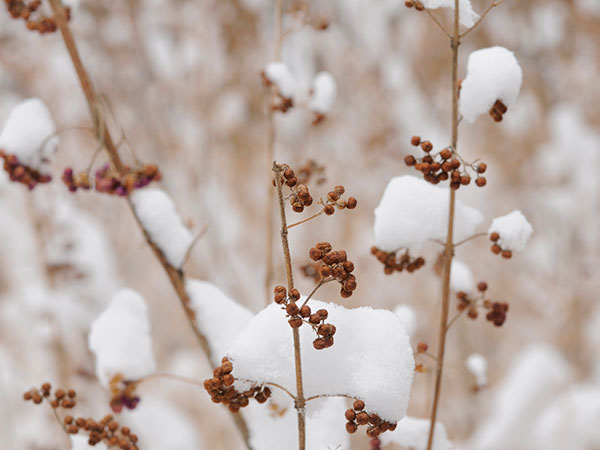
Later this month, selectively prune branches from flowering trees and shrubs and bring them indoors for forced blooming. Most flowering plants can be successfully forced if they have had at least a six-week cold period. Even branches with only foliage can make interesting arrangements. For flowering plants, choose branches with plenty of fat flower buds. Prune carefully, using proper pruning techniques, taking care not to interfere with the natural shape of the tree or shrub. Branches should be at least 1 foot long, cut when the temperature is above freezing. Lay branches overnight in a bathtub filled with room-temperature water. Make cross cuts in stem ends or smash the ends of very large branches so they can quickly take up water. Arrange them in a bucket or vase and keep them in a 60-degree room out of direct sunlight. Change the water every other day. As buds begin to swell or color up, make final arrangements and bring into a cool room, out of direct sun. Good choices for forcing in January and February include serviceberry (Amelanchier), magnolia (Magnolia), flowering quince (Chaenomeles), forsythia (Forsythia), crabapple or apple (Malus), flowering pear (Pyrus), flowering cherry (Prunus), honeysuckle (Lonicera), spring-flowering witch hazel (Hamamelis vernalis) and redbud (Cercis).
Light pruning of deciduous trees and shrubs can be done this month, weather permitting. Heavy pruning is best done in late winter or early spring immediately before bud break. Another time to prune ornamental flowering trees is immediately after they flower. (This avoids sacrificing their spring flower display.) Fruit trees are best pruned in late February or early March. Oak trees must be pruned in dormant months to minimize risk of oak wilt disease. Immediately prune back any branches damaged by snow and ice.
If tree branches become covered with ice, let the ice melt naturally rather than cracking it with a heavy object. If large evergreen branches are anchored to the ground with snow, gently sweep off snow with a soft broom and then elevate the tree branch from underneath. Using heavy objects like shovels risks cutting the tree bark — a possible point of entry for infection and insect attack.
Continue to monitor for animal damage if this has been a problem in the past. Rabbits will gnaw or strip off lower bark from trees. They can stand on top of snow piles to reach higher up on trees. Young bucks will rub their antlers on tree trunks as they try to remove the velvet. Create physical barriers such as deer netting, snow fencing, or hardware cloth tacked around tree trunks.
Check newly planted softwood trees for frost cracks or sun scald injury that might occur when winter temperatures fluctuate dramatically from a sunny warm day to a subzero night. Consider wrapping vulnerable tree trunks with protective wrap in fall and remove wrap in spring.
If necessary, construct burlap screening supported by wooden stakes to protect evergreens in path of salt spray.
This is the month to check host plants for overwintering Eastern tent caterpillar egg cases. Check crabapple, apple, hawthorn, mountain ash, flowering cherry, and other members of the rose family for signs of dark, iridescent egg cases encircling small twigs, giving a pencil-like shape to the twig.

